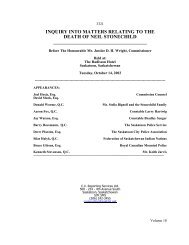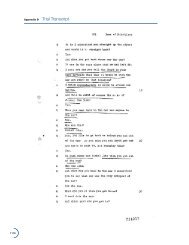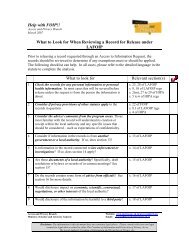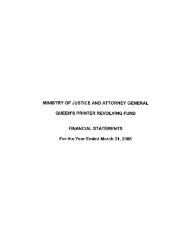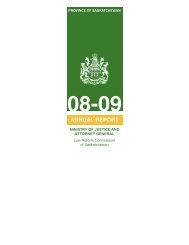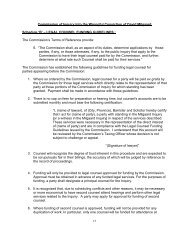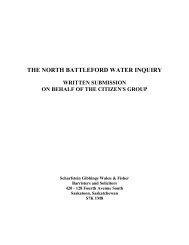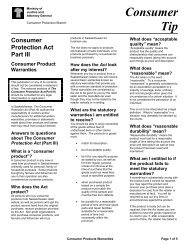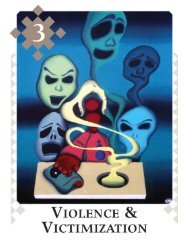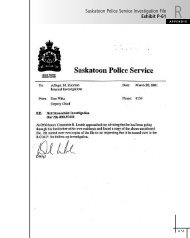Appendix K Memorandum of Law - s. 9(2) of the Canada Evidence Act
Appendix K Memorandum of Law - s. 9(2) of the Canada Evidence Act
Appendix K Memorandum of Law - s. 9(2) of the Canada Evidence Act
Create successful ePaper yourself
Turn your PDF publications into a flip-book with our unique Google optimized e-Paper software.
<strong>Appendix</strong> K <strong>Memorandum</strong> <strong>of</strong> <strong>Law</strong><br />
o<strong>the</strong>r witnesses, as he might heret<strong>of</strong>ore have done, and may still do, if <strong>the</strong> witness is unfavourable, but may also,<br />
by leave <strong>of</strong> <strong>the</strong> Judge, prove that he has made inconsistent statements.<br />
…<br />
Whatever is <strong>the</strong> meaning <strong>of</strong> <strong>the</strong> word “adverse,” <strong>the</strong> mere fact <strong>of</strong> <strong>the</strong> witness being in that predicament is not to<br />
confer <strong>the</strong> right <strong>of</strong> discrediting him in this way. The section obviously contemplates that <strong>the</strong>re may be cases where<br />
<strong>the</strong> Judge may properly refuse leave to exercise <strong>the</strong> right, though in his opinion <strong>the</strong> witness prove “adverse.”<br />
And as <strong>the</strong> Judge’s discretion must be principally, if not wholly, guided by <strong>the</strong> witness’s behaviour and language<br />
in <strong>the</strong> witness-box (for <strong>the</strong> Judge can know nothing, judicially, <strong>of</strong> his earlier conduct), it is not improbable that<br />
<strong>the</strong> legislature had in view <strong>the</strong> ordinary case <strong>of</strong> a Judge giving leave to a party producing a witness who proves<br />
hostile to treat him as if he had been produced by opposite party, so far as to put to him leading and pressing<br />
questions, and that <strong>the</strong> purpose <strong>of</strong> <strong>the</strong> section is to go a step fur<strong>the</strong>r in this direction, by giving <strong>the</strong> Judge power<br />
to allow such a witness to be discredited by proving his former inconsistent statements, as if he were a witness<br />
on <strong>the</strong> o<strong>the</strong>r side. 26<br />
Greenough v. Eccles holds that a party is not allowed to use a prior inconsistent statement to<br />
demonstrate <strong>the</strong> ‘adversity’ <strong>of</strong> <strong>the</strong>ir witness. Ra<strong>the</strong>r, s. 22 <strong>of</strong> <strong>the</strong> Common <strong>Law</strong> Procedure <strong>Act</strong> required<br />
a judge to declare a witness ‘adverse’ before an inconsistent statement could be put to that witness for<br />
<strong>the</strong> purpose <strong>of</strong> challenging his or her credibility. Therefore, while s. 22 <strong>of</strong> <strong>the</strong> Common <strong>Law</strong> Procedure <strong>Act</strong><br />
resolved <strong>the</strong> common law debate respecting a party’s ability to a prior inconsistent statement to challenge<br />
<strong>the</strong> credibility <strong>of</strong> his or her own witness, <strong>the</strong> overall result <strong>of</strong> <strong>the</strong> ruling in Greenough v. Eccles was <strong>the</strong><br />
creation <strong>of</strong> a procedural ‘conundrum’ or ‘catch-22’ since a party calling a witness might <strong>of</strong>ten need to use<br />
a prior inconsistent statement to prove adversity <strong>of</strong> that witness, but is prohibited from relying on <strong>the</strong> prior<br />
statement until adversity is proven by o<strong>the</strong>r means.<br />
The procedural conundrum in s. 9(1) <strong>of</strong> <strong>the</strong> CEA (and its English antecedents and Commonwealth<br />
counterparts) was regularly noted in cases decided after Greenough v. Eccles. See, for instance,<br />
R. v. May 27 , where <strong>the</strong> issue <strong>of</strong> using a prior statement to prove adversity under s. 9(1) <strong>of</strong> <strong>the</strong> CEA was<br />
considered and decided in <strong>the</strong> negative by a majority <strong>of</strong> <strong>the</strong> Court. However, some <strong>of</strong> <strong>the</strong> Courts that<br />
recognized <strong>the</strong> procedural ‘catch-22’ arising from Greenough v. Eccles began interpreting <strong>the</strong> section in<br />
a manner that would remedy <strong>the</strong> defect. 28 Three <strong>of</strong> those cases were The People (Attorney-General) v.<br />
Hannigan 29 , R. v. Hunter 30 , and Wawanesa (OCA) 31 .<br />
Hannigan concerned an application for leave to appeal a trial judge’s decision to declare as adverse<br />
a witness called by <strong>the</strong> prosecution. The witness’ evidence at trial was <strong>the</strong> same as his evidence at<br />
<strong>the</strong> deposition. However, <strong>the</strong> witness had made a prior oral inconsistent statement to a prison guard.<br />
Counsel, seeking leave, argued that it was wrong for <strong>the</strong> trial judge to consider, in <strong>the</strong> absence <strong>of</strong> <strong>the</strong> jury,<br />
26 Greenough v. Eccles, supra note 24 at pp. 162 and 163.<br />
27 (1915) 23 C.C.C. 469 (BCCA) (“May”). Greenough v. Eccles was followed in <strong>Canada</strong> by <strong>the</strong> majority <strong>of</strong> <strong>the</strong> British<br />
Columbia Court <strong>of</strong> Appeal in May.<br />
28 Alan Bryant states that ‘[i]n Australia, <strong>Canada</strong>, England and Ireland, courts have recognized <strong>the</strong> principle that a<br />
prior inconsistent statement or o<strong>the</strong>r extrinsic evidence is admissible to prove <strong>the</strong> witness is adverse in <strong>the</strong> statutory<br />
sense’: see The Statutory Rule, supra note 11 at p. 120; Bryant cites a number <strong>of</strong> cases from <strong>the</strong>se jurisdictions<br />
(including many decided prior to 1970) to support this proposition : (i) Australia – R. v. Hunter [1956] V.R. 31 and<br />
McLellan v. Bowyer [1962] A.L.R. 243; (ii) England – R. v. Fraser & Warren (1956), 40 Cr. App. R. 160; Pound v.<br />
Wilson (1865) 4 F. & F. 301; 176 E.R. 574; Martin v. The Travellers Insurance Company (1859) 1 F. & F.301; 175<br />
E.R. 828; Dear v. Knight (1859)1 F. & F. 433; 175 E.R. 796; Faulkner v. Brine (1858) 1 F. & F. 254; 175 E.R. 715; and<br />
Amstell v. Alexander (1867) 16 L.T. 830; (iii) Ireland – R. v. Hannigan, [1941] Ir. R. 252; and (iv) <strong>Canada</strong> – Wawanesa<br />
Mutual Insurance Co. v. Hanes, [1961] O.R. 495; Boland v. Globe and Mail, [1961] O.R. 712; R. v. Cohen W.W.N.<br />
336; R. v. Collerman [1964] 43 C.R. 118; R. v. Lessard, [1968] R.L. 186. See also A. Snelling, “Impeaching Own<br />
Witness” (1954) 28 A.L.J. 70 and H.H. Bell, “Impeaching Own Witness” 34 A.L.J. 200.<br />
29 [1941] Ir. R. 252 (Irish Court <strong>of</strong> Criminal Appeal) (“Hannigan”).<br />
30 [1956] V.L.R. 31 (a decision <strong>of</strong> <strong>the</strong> Full Court <strong>of</strong> <strong>the</strong> Supreme Court <strong>of</strong> Victoria in Australia) (“Hunter”).<br />
31 Wawanesa (OCA), supra note 21.<br />
2582



